Abstract
Tonoplast aquaporins (intrinsic proteins, TIPs) have been indicated to play important roles in plant tolerance to water deficit and salinity. However, the functions of wheat TIPs in response to the stresses are largely unknown. In this study, we observed that transgenic plants overexpressing wheat TaTIP4;1 in Arabidopsis and rice displayed clearly enhanced seed germination and seedling growth under drought, salt and osmotic stress. Compared with wild type plants, Arabidopsis and rice overexpression lines had heightened water contents, reduced leaf water loss, lowered levels of Na+, Na+/K+, H2O2 and malondialdehyde, and improved activities of catalase and/or superoxide dismutase, and increased accumulation of proline under drought, salinity and/or osmotic stresses. Moreover, the expression levels of multiple drought responsive genes clearly elevated upon water dehydration, and the transcription of some salt responsive genes was markedly induced by NaCl treatment in the overexpression lines. Also, the yeast cells containing TaTIP4;1 showed increased tolerance to NaCl and mannitol, and mutation in one of three serines of TaTIP4;1 caused decreased tolerance to the two stresses. These results suggest that TaTIP4;1 serves as an essential positive regulator of seed germination and seedling growth under drought, salt and/or osmotic stress through impacting water relations, ROS balance, the accumulation of Na+ and proline, and stimulating the expression of dozens of stress responsive genes in Arabidopsis and rice. Phosphorylation may modulate the activity of TaTIP4;1.
Keywords:
wheat TaTIP4; 1; Arabidopsis; rice; seed germination; root growth; drought; salinity; osmotic stress 1. Introduction
Drought and high salinity are two crucial environmental stresses that greatly limit plant growth, development and crop productivity worldwide. Drought reduces cellular water contents, and salinity disturbs ion balance. Both stressors can result in hyperosmotic stress. Drought, salt and osmotic stresses also enable the accumulation of excess reactive oxygen species (ROS) in cells, causing oxidative stress in plants [1,2,3]. During evolution, plants have developed complicated regulatory mechanisms to withstand these environmental challenges and the resultant secondary stresses, including the perception and transduction of stress signals, the activation of stress responsive transcription factors, followed by the induction of the expression of a large number of functional genes [3,4,5,6].
Typically, drought signals are sensed and relayed downstream to promote the increase in water uptake from the soil. On the other hand, dehydration stress stimulates the biosynthesis of hormone abscisic acid (ABA) to induce stomatal closure, preventing water loss. Water deficit can also lead to the enhancements in the activities of different antioxidant enzymes like superoxide dismutase (SOD), catalase (CAT), ascorbate peroxidase (APX) and peroxidase (POD) to sequester ROS, and lead to the production of various osmotic stress-protectant metabolites such as proline and trehalose [5,6,7].
Both ABA-dependent and ABA-independent signal regulatory systems have been demonstrated to initiate gene transcription in response to water scarcity in plants. Under dehydration stress, ABA triggers the activation of the key positive regulators, subclass III sucrose nonfermenting (SNF) 1-related kinases (SnRK2s) SnRK2.2, SnRK2.3 and SnRK2.6, which phosphorylate and activate some transcription factors, for instance AREBs/ABFs (ABA-response element (ABRE)-binding proteins/ABRE binding factors), further inducing the expression of numerous stress-responsive genes. In contrast, several transcription factors including dehydration responsive element binding protein 1/C-repeat binding factor (DREB1/CBF) and DREB2 function in ABA-independent manner to increase the transcription of multiple drought-responsive genes under drought stress [5,6,8,9]. To date, many components acting downstream of drought signaling have been identified in plants. They include AtDREB2A, AtDREB1B, AtDREB2B, response to dehydration 29A (AtRD29A)/Low-temperature-responsive protein 78 (AtLTI78) and AtRD29B in Arabidopsis, and OsDREB1, OsDREB2, OsNAC1, OsNAC2 and responsive to abscisic acid 16 (OsRAB16C) in rice [9,10,11,12,13,14].
Like drought stress, salinity stimulates the enhancement of ABA levels in tissues, triggering the ABA relevant responses. Salt stress can also induce the increases in the activities of multiple antioxidases and promote the production of osmotic protectant substances [15]. Moreover, ionic stress, the major challenges imposed by salinity, causes the activation of transcriptional regulatory mechanisms of plants to cope with its adverse effects. Upon saline stress, excess Na+ is sensed by the salt receptor, subsequently induces the enhancement of cytosolic Ca2+ concentrations in plants. The Ca2+ signal is decoded by the Ca2+-binding proteins salt overly sensitive 3 (SOS3) and SOS3-like calcium-binding protein8/calcineurin B-like 10 (SCaBP8/CBL10), which activate the serine/threonine protein kinase SOS2. Then, the activated SOS2 phosphorylates and elicits the plasma membrane Na+/H+ antiporter SOS1 to transport Na+ from the cytoplasm to the apoplast. SOS2 and SOS3 also positively modulate the activity of NHX1, a vacuolar Na+/H+ antiporter. NHX1 transfers Na+ from the cytoplasm to the vacuole in plants upon salinity [3,4,6].
Aquaporins (AQPs) are universal water channel proteins that selectively and reversibly assist the movement of water and small neutral solutes across cellular membrane in plants and other organisms [16,17,18]. They regulate plant growth and development through affecting water relations, cell turgor pressure, root water absorption and leaf transpiration, etc. Moreover, AQPs play essential roles in plant response to diverse biotic and abiotic stresses [16,17,18,19]. In higher plants, AQPs can be divided into five subfamilies, the plasma membrane intrinsic proteins (PIPs), tonoplast intrinsic proteins (TIPs), nodulin 26-like intrinsic proteins (NIPs), small basic intrinsic proteins (SIPs) and uncategorized intrinsic proteins (XIPs). Among these, PIPs and TIPs are the dominant players. They mainly contribute to the transport of water across the plasma membrane and tonoplast, respectively. TIPs can be further classified into several subtypes for example TIP1 and TIP2. Each subtype is designated as TIP1;1, TIP1;2, and so on [16,17,19]. There exist 10 TIP members both in Arabidopsis and rice. Eleven TIPs have been identified in wheat, the major grain crop in the world [20,21,22].
It has been addressed that some TIPs exert positive effects in plant tolerance to water deficit, salinity and osmotic stress [23,24]. For instance, overexpression of a ginseng PgTIP1 increases drought tolerance in Arabidopsis, and enhances salt stress tolerance in Arabidopsis and soybean [25,26,27,28]. Transgenic Arabidopsis plants overexpressing Jatropha curcas TIP1;3 display improved seed germination rates, and promoted seedling growth and seed viability under salt, drought and/or osmotic stresses [29]. Likewise, ectopic expression of Thellungiella salsuginea TsTIP1;2 in Arabidopsis clearly increases plant tolerance to drought, salt and oxidative stresses, and overexpression of tonoplast TsMIP6 in rice leads to elevated tolerance to salt stress [30,31]. Sade et al. reported that constitutive expression of tomato SITIP2;2 markedly enhances fruit yield under water stress [32]. Overexpression of Glycine soja GmTIP2;1, GmTIP1;7 and GmTIP1;8 in soybean also results in noticeable improvement in salt and drought tolerance [33]. However, whether wheat TIPs have roles in plant response to dehydration and salt stress is unclear, and the underlying mechanism remains to be determined. In the present study, we provide evidence that TaTIP4;1 positively regulates seed germination and seedling growth in Arabidopsis and rice under drought, osmotic and salt stress through altering water relations, ROS homoeostasis and Na+/K+ balance, increasing the levels of proline and inducing the transcription of a multitude of stress responsive genes.
2. Results
2.1. TaTIP4;1 Expression Was Strongly Induced by PEG, NaCl and H2O2 in Wheat
TIPs have been addressed to fulfill functions in plant adaption to various abiotic stresses [23]. To gain insight into the roles of TaTIP4;1 in response to water stress and salinity, changes in its transcript abundances were firstly examined in wheat under stress. Treatment of seedlings with 10% PEG significantly enhanced the transcriptional levels of TaTIP4;1 at 6, 9, 12 and 24 h in leaves and 6 and 9 h in roots. Likewise, 200 mM NaCl led to clear increases in mRNA abundances of TaTIP4;1 at all treatment time points in leaves, and 3, 6, 9 and 24 h in roots (Figure 1A,B). Exogenous 100 μM ABA had evident stimulation effects on TaTIP4;1 expression at 6 and 9 h in roots but had no induced impact in leaves (Figure 1C). Application of 10 mM H2O2 resulted in pronounced enhancements of TaTIP4;1 mRNA levels at 3, 6 and 12 h in leaves and 6 and 9 h in roots (Figure 1D). These results indicate that TaTIP4;1 was markedly induced by drought, salinity, ABA and H2O2. Tissue expression of TaTIP4;1 was also measured. It was found that TaTIP4;1 was strong expressed in roots, stems and leaves (Figure S1).
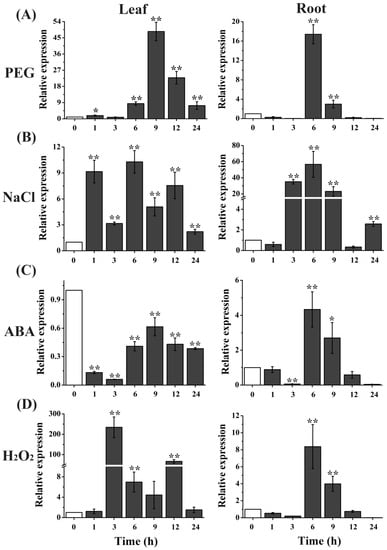
Figure 1.
Expression profiles of TaTIP4;1 after treatment with PEG6000, NaCl, ABA and H2O2 in wheat. Two-week-old wheat seedlings were treated with 10% PEG 6000 (A), 200 mM NaCl (B), 100 μM ABA (C) or 10 mM H2O2 (D) for indicated periods of time. qPCR analysis of TaTIP4;1 transcription was performed. TaActin was used as an internal control. Data are mean ± SD (n ≥ 3). Single and double asterisk mean that the data from the treatment samples significantly differed from the control at * p < 0.05 and ** p < 0.01 levels respectively by student’s t test.
2.2. Generation of Transgenic Plants Overexpressing TaTIP4;1 in Arabidopsis and Rice
To further study the functions of TaTIP4;1, we cloned its coding sequence (CDS) and introduced it into Arabidopsis and rice, respectively. Several T3 overexpression lines were generated. Arabidopsis line 6 (OE6), 9 (OE9), 10 (OE10) and rice line 1 (OE1), 2 (OE2) and 3 (OE3) showed clearly heightened expression levels of TaTIP4;1 (Figure S2). Also, the empty vector driven by 35S promoter was introduced into Arabidopsis, and transgenic VC (vector control) plants were obtained. As expected, TaTIP4;1 mRNAs were not detected in VC lines (Figure S2).
2.3. Overexpression of TaTIP4;1 Improved Drought Tolerance of Arabidopsis
To determine whether TaTIP4;1 expression influences plant tolerance to drought stress, differences in the growth of OE6, OE9, OE10, wild type (WT) and VC were compared. Before treatment, the performances of the three OE lines were similar to those of WT and VC (Figure 2A). When water was withheld for another 2 weeks and 4 weeks, the growth of all plants was severely inhibited. Notably, the three overexpressors were observably more tolerant to drought stress than WT and VC. The OE lines still had some green leaves at 2 weeks, and were alive at 4 weeks whereas WT and VC had more dark brown leaves at 2 weeks, and looked dead post 4 weeks of water stress treatment. After rewatering for 1 week following 4-week drought stress, the OE lines survived and resumed growth, but WT and VC plants died (Figure 2A). Moreover, the survival rates and leaf relative water contents were significantly higher in the three OE lines than in WT and VC under drought stress (Figure 2B,C). Additionally, leaf water loss rates of the TaTIP4;1 overexpression lines were clearly smaller than those of WT and VC plants (Figure 2D). These results suggest that TaTIP4;1 positively modulates drought tolerance of Arabidopsis.
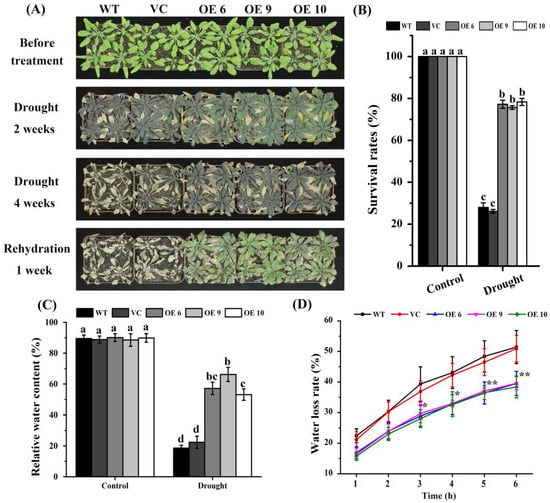
Figure 2.
TaTIP4;1 overexpression improved drought tolerance in Arabidopsis. (A) Growth performances of plants. Four-week-old plants of Arabidopsis WT, VC, OE6, OE9 and OE10 were not watered for 2 and 4 weeks, respectively, and then rewatered for 1 week. (B) The survival rates of plants after drought stress for 4 weeks. (C) Relative water contents of leaves after drought stress for 4 weeks. Different lowercase letters show that the values from the plants significantly differed from each other by one way ANOVA and Tukey’s honestly significant difference test (Tukey’s HSD test) (p < 0.05). (D) Leaf water loss rates of four-week-old plants. Single and double asterisk indicate that the values of TaTIP4;1 overexpressors significantly differed from WT and VC plants at * p < 0.05 and ** p < 0.01 levels respectively by student’s t test. Data are mean ± SD (n ≥ 3).
2.4. Arabidopsis TaTIP4;1 Overexpressors Had Increased Seed Germination Rates under Salt and Osmotic Stress
To examine whether TaTIP4;1 plays a role in seed germination under stresses, seeds of OE6, OE9, OE10, WT and VC were sterilized, stratified and sown on solid 1/2 MS medium or 1/2 MS medium supplemented with NaCl (50 and 75 mM) or mannitol (100 and 200 mM), and grown in a chamber for a period of time. In 1/2 MS medium, nearly all the seeds were germinated at 3 d, no significant differences in germination rates among the plants were observed (data not shown). At 10 d, the seed germination rates of the three overexpression lines were noticeably higher than those of WT and VC in 1/2 MS medium containing 50 mM NaCl, 75 mM NaCl, 100 mM manitol or 200 mannitol (Figure 3), hinting that TaTIP4;1 aids seed germination in Arabidopsis after challenge by saline and osmotic stimuli.
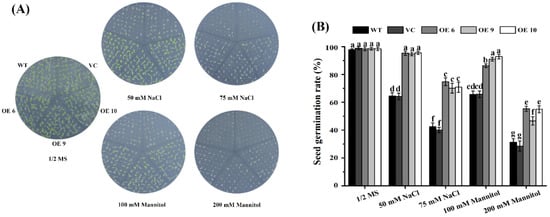
Figure 3.
Effects of NaCl and mannitol on seed germination of Arabidopsis TaTIP4;1 overexpressors. (A) Phenotypes of seed germination and seedling growth of various plants. OE6, OE9, OE10, WT and VC were germinated in 1/2 MS medium not containing or containing 50 mM NaCl, 100 mM NaCl, 100 mM mannitol or 200 mM mannitol for 10 day. (B) Seed germination rates of various plants in (A). Data are mean ± SD (n ≥ 3). Different lowercase letters above the error bars reveal the data of various plants significantly differed from each other by one way ANOVA and Tukey’s HSD test (p < 0.05).
2.5. Arabidopis Seedlings Overexpressing TaTIP4;1 Had Enhanced Tolerance to Salinity and Osmotic Stress
We then investigated the roles of TaTIP4;1 in seedling growth of Arabidopsis under salt and osmotic stress. Five-day old seedlings of OE6, OE9, OE10, WT and VC were transferred to 1/2 MS medium with or without different concentrations of NaCl or mannitol, and grown in a chamber for another 10 d. In 1/2 MS medium, all plants had similar growth performances. No marked difference in root lengths among the plants was seen. However, in 1/2 MS medium containing 100 mM NaCl, 125 mM NaCl, 300 mM mannitol or 400 mM mannitol, the elongation of primary roots of the three OE lines was observably faster than WT and VC plants (Figure 4).
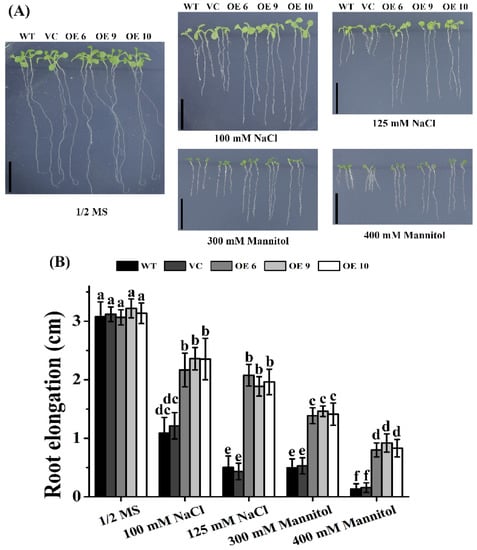
Figure 4.
Effects of NaCl and mannitol on primary root growth of Arabidopsis transgenic plants overexpressing TaTIP4;1. (A) Seedling growth performances. Five-day old seedlings of OE6, OE9, OE10, WT and VC were transferred to 1/2 MS medium supplemented without or with 100 mM NaCl, 125 mM NaCl, 300 mM mannitol or 400 mM mannitol, and grown for another 10 days. Scale bars are 1 cm. (B) Increments in the length of primary roots of various lines in (A). Values are mean ± SD (n ≥ 3). Different lowercase letters above the error bars indicate that the values of the lines significantly differed from each other by one way ANOVA and Tukey’s HSD test (p < 0.05).
The responses of TaTIP4;1 overexpressors to 250 mM NaCl in soil were also studied. As expected, all the three OE lines grew better than WT and VC after treatment with NaCl for another 2 weeks and especially 4 weeks. After treatment for 4 weeks, the OE lines showed more than two times of survival rates of the WT and VC (Figure S3). Together, these data imply that TaTIP4;1 positively affects Arabidopsis tolerance to NaCl and osmotic stress.
2.6. Seed Germination of Rice TaTIP4;1 Overexpressors Was Insensitive to Salt and Osmotic Stress
The effects of TaTIP4;1 expression on seed germination were further investigated in rice under saline and osmotic stress. It was found that seeds of rice OE line 1, 2 and 3 germinated faster than those of WT in the presence of 5% PEG6000, 10% PEG6000, 50 mM NaCl, and 75 mM NaCl. After treatment with PEG6000 or NaCl for 7 d, the three OE lines had pronouncedly higher seed germination rates than WT plants. In contrast, seed germination rates of the OE plants were not significantly different from those of WT under normal growth conditions (Figure 5), indicating that TaTIP4;1 acts as a positive modulator of rice tolerance to both water deficit and NaCl stress in term of seed germination.
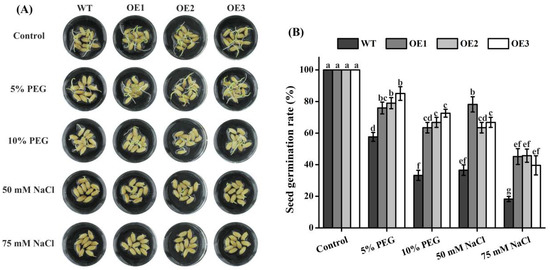
Figure 5.
Effects of PEG6000 and NaCl on seed germination of rice WT and TaTIP4;1 overexpressors. (A) Seed germination performances. Seeds of WT, OE1, OE2 and OE3 were germinated in the absence or presence of 5% PEG6000, 10% PEG6000, 50 mM NaCl or 75 mM NaCl for 7 days. (B) Seed germination rates of all lines in (A). Data are mean ± SD (n ≥ 3). Distinct lowercase letters above the error bars show that the data of various plants significantly differed from each other by one way ANOVA and Tukey’s HSD test (p < 0.05).
2.7. Rice TaTIP4;1 Overexpressors Grew Better Than WT after Challenged by PEG6000, Salt and Mannitol
We next tested whether TaTIP4;1 overexpression impacts the growth of rice seedlings under stresses. Three old-day seedlings of OE1, OE2, OE3 and WT grown in liquid MS medium were moved to MS medium without or with different concentrations of PEG6000, NaCl or mannitol for a period of time. The three OE lines showed no obvious growth differences from WT in MS medium. However, all the OE lines grew notably faster or better than WT in MS medium supplied with 5% PEG6000, 10% PEG6000, 50 mM NaCl, 75 mM NaCl, 200 mM NaCl or 200 mM mannitol (Figure 6 and Figure S4). The overexpression lines had apparent longer roots and higher shoots under stresses. The heights of OE plants were more than 1.7, 2.0, 1.5 and 1.8 folds in MS medium containing 5% PEG6000, 10% PEG6000, 50 mM NaCl and 75 mM NaCl, respectively (Figure 6). Also, the survival rates of OE1, OE2 and OE3 were 3.6, 3.3 and 3.5 folds of WT, respectively, after grown under 200 mM NaCl for 10 d, and were 2.5, 2.3 and 2.9 times of WT respectively after grown under 200 mM mannitol for 10 d (Figure S4). Furthermore, the leaf water loss of OE1, OE2 and OE3 was clearly slower than that of WT at all time points (Figure S4). These data suggest that TaTIP4;l facilitates rice seedling growth under drought, salt and osmotic stress likely via reducing water loss in tissues.
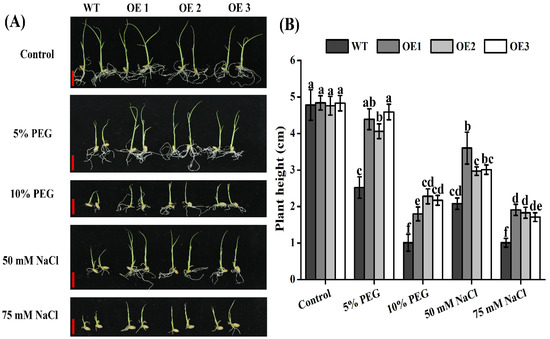
Figure 6.
Effects of PEG6000 and salt on the growth of rice WT and transgenic lines. (A) Seedling growth performances. Three-day-old seedlings of WT and transgenic lines grown in liquid 1/2 MS medium were treated without or with 5% PEG6000, 10% PEG6000, 50 mM NaCl or 75 mM NaCl for another one week. Scale bars are 1 cm. (B) Plant height of all plants in (A). Data are mean ± SD (n ≥ 3). Diverse lowercase letters above the error bars represent that the height values of various plants were significantly different from each other by one way ANOVA and Tukey’s HSD test (p < 0.05).
2.8. Salt-Stimulated Increases of Na+ Contents Were Markedly Reduced in TaTIP4;1 OE Lines of Arabidopsis and Rice
In order to understand whether TaTIP4;1 overexpression alters the balance of Na+ and K+ under salinity, the contents of Na+ and K+ in Arabidopsis OE6, OE9, OE10, WT and VC were compared. Treatment of the seedlings with 250 mM NaCl led to clear increases in the concentrations of Na+, and the decreases in the levels of K+ in WT, VC and OE lines. Noteworthily, the increments of Na+ levels in the OE lines markedly smaller than those in WT and VC whereas the decrements of K+ in the OE lines were similar to WT and VC. Thus, the Na+/K+ ratios of the OE plants were significantly declined compared with WT and VC under salt stress. We also investigated the effects of high salinity on changes in levels of Na+ and K+ in rice. Similar to Arabidopsis, rice OE1, OE2, OE3 and WT plants showed remarkably enhanced contents of Na+ and diminished levels of K+ after exposure to 200 mM NaCl for 5 d. However, the enhancements in Na+ levels were notably smaller in the OE lines than in WT while the diminishments of K concentrations in the OE plants were parallel to WT (Figure 7). Collectively, these results support the notion that TaTIP4;1 overexpression causes the suppression of Na+ accumulation and the maintenance of K+ and Na+ balance in Arabidopsis and rice under saline stress.
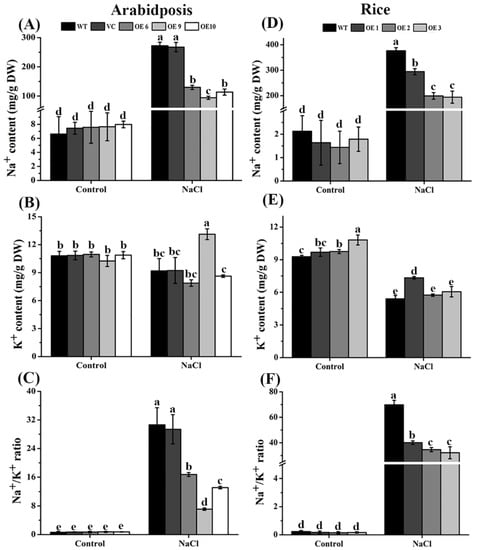
Figure 7.
Effects of salt on the accumulation of Na+ and K+ in WT and transgenic plants of Arabidopsis and rice. WT and various OE plants were exposed to NaCl for 2 weeks, and leaves of the plants were collected for measuring the contents of Na+ and K+. (A–C) were Na+ contents, K+ contents and Na+/K+ values in Arabidopsis, respectively; and (D–F) were Na+ contents, K+ contents and Na+/K+ values in rice, respectively. Values are mean ± SD (n ≥ 3). Different lowercase letters above the error bars indicate that the data of various plants significantly differed from each other by one way ANOVA and Tukey’s HSD test (p < 0.05).
2.9. Overexpression of TaTIP4;1 Altered H2O2 Accumulation, MDA Contents, the Activity of Some Antioxidases, and Proline Levels in Arabidopsis upon Drought and Salt Stress
To ascertain whether TaTIP4;1 expression in Arabidopsis modifies the levels of H2O2 and malondialdehyde (MDA), the activities of some antioxidant enzymes and proline contents, these physiological parameters were further examined. Under normal conditions, the H2O2 contents of OE6, OE9 and OE10 were similar to WT and VC. Application of drought for 7 d and 200 mM NaCl for 7 d caused considerable increases in H2O2 levels in all the plants. It is noteworthy that the rise in H2O2 concentrations in the OE lines was evidently smaller than that in WT and VC after PEG treatment whereas that in the OE lines was similar to WT and VC under salt stress (Figure 8A).
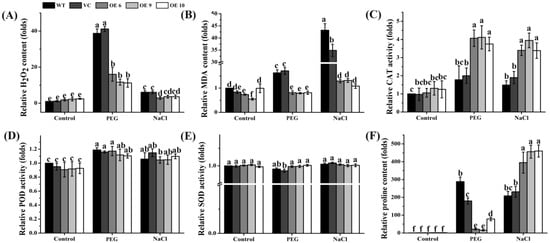
Figure 8.
Effects of PEG6000 and NaCl treatment on the levels of H2O2 and MDA, the activity of some antioxidases, and proline contents in Arabidopsis overexpressors of TaTIP4;1. (A) H2O2 levels. (B) MDA levels. (C–E) The activities of CAT, POD and SOD, respectively. (F) Proline levels. Fifteen-day-old WT, VC and TaTIP4;1 overexpression seedlings were treated with water or 200 mM NaCl for 7 d. Levels of H2O2 and MDA, the activity of some antioxidases, and proline contents were assayed. Data are mean ± SD (n ≥ 3). Distinct lowercase letters above the error bars reveal that the values of various plants significantly differed from each other by one way ANOVA and Tukey’s HSD test (p < 0.05).
MDA levels reflect the degree of lipid peroxidation in membranes. It was found that MDA contents pronouncedly enhanced in WT and VC rather than in the three OE lines after challenged by 300 mM PEG, and 200 mM NaCl (Figure 8B).
We detected the changes in the activities of CAT, POD and SOD, found that CAT activities substantially increased in the OE plants, and those in the OE lines markedly higher than WT and VC after treatment with 300 mM PEG or 200 mM NaCl (Figure 8C). POD activities marginally elevated and SOD activities did not obviously altered in all plants after exposure to the PEG and NaCl stress, and no differences in these activities were observed among all the plants under normal conditions (Figure 8D,E).
The proline contents of the lines of OE6, OE9, OE10, VC and WT drastically increased under PEG and salt stress but not under unstressed conditions. Moreover, the increments in proline levels of the OE lines were clearly smaller post PEG treatment but higher under NaCl stress than those in WT and VC plants (Figure 8F). Together, these results imply that TaTIP4;1 overexpression results in the alleviation of oxidative stress possibly through enhancing the activities of CAT, and the improvement of proline levels in Arabidopsis under water stress and/or salinity stress.
2.10. TaTIP4;1 Expression in Rice Affected the Levels of H2O2 and MDA, Antioxidase Activities and Proline Accumulation under Salt and Osmotic Stress
In rice, H2O2 contents in leaves from OE1, OE2 and OE3 were similar to those from WT under normal growth conditions. Treatment with 200 mM NaCl did not cause apparent differences in H2O2 concentrations between the OE lines and WT. However, application of 250 mM mannitol resulted in notable enhancements in H2O2 levels in WT but not in the three OE lines (Figure S5A). MDA levels in WT were remarkably increased, and those in OE lines were slightly heightened upon both NaCl and mannitol stress (Figure S5B). SOD activities under 200 mM NaCl, and CAT activities in the presence of 250 mM mannitol were evidently decreased in WT, but marginally changed in the OE lines. POD activities of the OE lines did not noticeably differ from WT under both stress and control conditions (Figure S5C–E). NaCl and mannitol challenges resulted in marked elevation of proline levels in the three OE lines rather than in WT plants (Figure S5). Our findings suggest that the enhancements of TaTIP4;1 transcripts in rice cause diminished oxidative stress and promoted biosynthesis of proline under salt and osmotic stress.
2.11. The Expression of Several Drought Responsive Genes Was Upregulated in TaTIP4;1 OE Lines of Arabidopsis and Rice under Water Stress
To clarify whether TaTIP4;1 overexpression influences the mRNA abundances of drought related genes in Arabidopsis and rice, the expression levels of some stress responsive genes were detected. When WT and OE plants were challenged by water dehydation, the transcription of AtDREB1B, AtRD29A and AtRD29B in Arabidopsis, and OsDREB2, OsNAC1, OsPIP2;1, OsRAB16C and OsPOX1 in rice was markedly induced. Of note, the elevated amplitudes of the expression levels of these genes in the OE lines clearly higher than those in WT (Figure 9 and Figure S6), pointing to the important roles of TaTIP4;1 in promoting the expression of these drought associated genes under water stress.
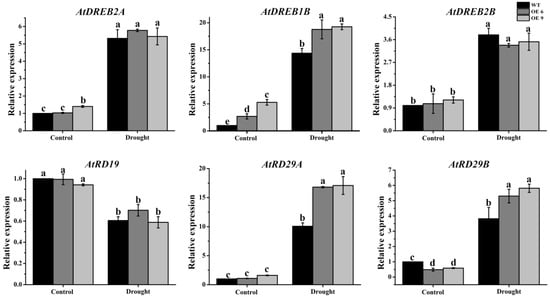
Figure 9.
Effects of water deficit on the transcription changes of multiple drought responsive genes in Arabidopsis TaTIP4;1 overexpressors. Fifteen-day-old WT, VC and TaTIP4;1 transgenic plants were dehydrated for 6 h. Gene expression was detected by quantitative real-time RT-PCR (qRT-PCR) method, AtActin2 was used as the internal control. Data are mean ± SD (n ≥ 3). Diverse lowercase letters above the error bars show significant differences in the values among the plants by one way ANOVA and Tukey’s HSD test (p < 0.05).
2.12. The Transcript Abundances of Multiple Salt Responsive Genes Increased in TaTIP4;1 OE Lines of Arabidopsis and Rice upon Salinity
NaCl caused changes in the expression levels of multiple salinity relevant genes were analyzed in WT and the OE lines of Arabidopsis and rice. Salt stress led to noticeable elevations in mRNA abundances of AtSOS2, AtNHX1, AtRD29A, AtRD29B, AtPKS5 and AtCAT1 in Arabidopsis, and of OsPIP2;1, OsP5CS and OsCATB in rice. Moreover, the increments of gene expression in the OE plants were prominently greater than those in WT in both Arabidopsis and rice (Figure 10 and Figure S7). These data indicate that TaTIP4;1 positively modulates the transcription of these salt response genes after exposure to saline conditions.
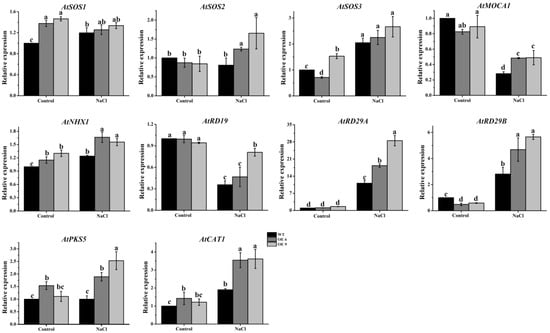
Figure 10.
Effects of NaCl on the expression patterns of multiple salt responsive genes in Arabidopsis transgenic plants overexpressing TaTIP4;1. Fifteen-day-old WT, OE6 and OE9 seedlings were treated with or without 200 mM NaCl for 6 h. Gene expression was evaluated by qRT-PCR method, AtActin2 was used as the internal control. Values are mean ± SD (n ≥ 3). Diverse lowercase letters above the error bars reveal remarkable differences in the values among the seedlings by one way ANOVA and Tukey’s HSD test (p < 0.05).
2.13. Phosphorylation Might Regulate TaTIP4;1 Activity in Adaptation to Salt and Osmotic Stress
The role of TaTIP4;1 in responding to salt and osmotic stress was further investigated in yeast. Under unstressful conditions, the growth of yeast cells expressing TaTIP4;1 in YPD + galactose medium was similar to that of the control cells (expressing the pYES2 empty vector). However, the yeast cells containing TaTIP4;1 in YPD + galactose supplied with NaCl or sorbitol grew observably faster than the control cells (Figure 11), indicating that TaTIP4;1 is a positive modulator in yeast tolerance to salinity and osmotic stress. When one of three serines at loci S83A, S201A or S207A in TaTIP4;1 was mutated to alanine, the recombinant yeast cells grew evidently slower than those bearing normal TaTIP4;1 under salt and sorbitol stress conditions (Figure 11). Our findings suggest that phosphorylation functions in adjusting the activity of TaTIP4;1 in yeast, further affecting the tolerance to saline and osmotic stresses.
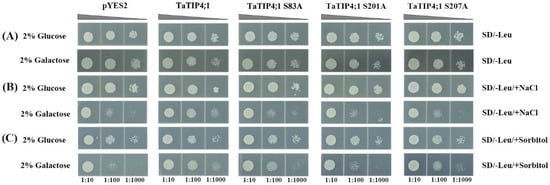
Figure 11.
The roles of TaTIP4;1 in yeast. Growth performances of yeast cells of INVSC1 containing normal or mutated TaTIP4;1 genes (at the 247th, 602th, 619th, respectively) in medium (SD/-Leu) supplied without (A) or with 50 mM NaCl (B) and 200 mM sorbitol (C) for 3 days at 30 °C. The reduced cell densities in the dilution series are shown by narrowing triangles when proceeding from left to right. Experiments were repeated three times.
3. Discussion
To date, the functions of wheat TIPs in responding to drought, high salinity and osmotic stresses are largely unknown. In this report, we found that TaTIP4;1 expression in wheat significantly increased by application of PEG, NaCl and H2O2. TaTIP4;1 was pronouncedly induced by PEG in leaves whereas it was upregulated by NaCl and ABA in roots (Figure 1). These data indicate that TaTIP4;1 may play more important roles in leaves through transferring water under dehydation conditions, while TaTIP4;1 may majorly function in roots in response to salt and ABA signalings in wheat.
It was observed that transgenic plants overexpressing TaTIP4;1 in Arabidopsis and rice exhibited improved drought tolerance, enhanced seed germination rate and seedling growth under salt and osmotic stress (Figure 2, Figure 3, Figure 4, Figure 5, Figure 6, Figures S3 and S4). Compared with WT, Arabidopsis and rice transgenic lines had increased water contents, diminished leaf water loss, lowered levels of Na+, Na+/K+, H2O2 and MDA, and improved activities of CAT and/or SOD, and increased concentrations of proline under stresses (Figure 2, Figure 7, Figure 8, Figures S4 and S5). Furthermore, the mRNA abundances of multiple drought responsive genes clearly increased under water deficit, and those of some salt responsive genes were upregulated by NaCl treatment (Figure 9, Figure 10, Figures S6 and S7). These results suggest that TaTIP4;1 serves as an essential positive regulator of seed germination and seedling growth under drought, salt and/or osmotic stress through impacting water relations, ROS balance, the accumulation of Na+ and proline, and eliciting the expression of dozens of stress responsive genes in Arabidopsis and rice.
It has been documented that overexpression of PgTIP1, JcTIP1;3, TsTIP1;2, TsMIP6, SlTIP2;2, GmTIP2;1, GmTIP1;7 and GmTIP1;8 markedly improves plant tolerance to drought, salinity and/or osmotic stress as indicated by increased seed germination and/or superior growth status [23,25,26,27,28,29,30,31,32,33,34], being in agreement with our findings (Figure 2, Figure 3, Figure 4, Figure 5, Figure 6, Figures S3 and S4). These results support the notion that TIPs play more general roles in plant response to drought, salt and osmotic stresses through facilitating water movement across the tonoplast. Peng et al. reported that overexpression of ginseng PgTIP1 results in reduced water deficit tolerance after grown in shallow (10 cm deep) pots [25]. Feng described that the mutant of Arabidopsis AtTIP2;2 has increased seedling growth upon drought, salinity and osmotic stresses [35]. These data are inconsistent with our results. The reason may be that wheat TaTIP4;1 has opposite effects from PgTIP1 and AtTIP2;2 on the direction of water transport across the tonoplast, or the regulatory mechanism of TaTIP4;1 is diverse from that of PgTIP1 and AtTIP2;2 under stress conditions.
After challenged by dehydration and/or salt stress, the decrements in leaf water contents and/or increments in leaf water loss rates of transgenic plants overexpressing PgTIP1, JcTIP1;3 or TsTIP1;2 are evidently arrested compared with those of WT plants [27,28,29], being in accordance with our findings (Figure 2 and Figure S4). These results imply that TIPs are of great importance in plant response to drought and salt stress via modulating water transportation.
We observed that salinity-induced increases in the Na+ contents and Na+ to K+ ratios in TaTIP4;1 overexpressors of Arabidopsis and rice were notably lower than those in WT (Figure 7). The results were consistent with those in transgenic plants overexpression of PgTIP1 in soybean [27,28], signifying that TIPs exert effects in ameliorating ion stress in plants upon saline conditions.
It has addressed that drought- and/or NaCl stress-triggered enhancements in levels of ROS and MDA in the overexpressors of PgTIP1, TsMIP6 and TsTIP1;2 are attenuated as compared with those in WT [26,28,30,31]. Moreover, high concentrations of NaCl caused increments in the activities of SOD, CAT, APX and POD are clearly higher in the overexpressors of PgTIP1 than in their corresponding WT plants [27,28]. Likewise, overexpression of TaTIP4;1 in Arabidopsis markedly suppressed the increase in the synthesis of H2O2 and heightened CAT activity under salt stress (Figure 8). These findings suggest that TIPs are essential for the regulation of redox balance in plants upon stress.
Sun et al. demonstrated that salt stress-stimulated increases in proline contents are pronouncedly higher in TsMIP6 transgenic plants of rice than in WT, being similar to our results from TaTIP4;1 overexpressors of Arabidopsis and rice under drought and salt stress (Figure 8 and Figure S5) [31]. These data hint that some TIPs modulate stress response through stimulating the production of proline.
Numerous lines of evidence indicate that the expression of many stress responsive genes is induced by drought and salinity stress in WT, and especially in the transgenic plants overexpressing PgTIP1 in Arabidopsis and soybean. These genes include Arabidopsis AtDREB1A/AtCBF3/AtDREB1A, zinc finger of Arabidopsis thaliana (AtZAT12), AtMYB15, cold-regulated 47 (AtCOR47), inducer of CBF expression 1 (AtICE1), AtLTI78, soybean GmPOD, GmAPX1, GmSOS1, clathrin light chains (GmCLC1), GmNHX1, GmSOS1, GmCAT1, 9-cis-epoxycarotenoid dioxygenase 1 (GmNCED1) and Δ1-pyrroline-5-carboxylate synthetase 1 (GmP5CS1) [26,27,28]. We also found that the expression levels of a number of stress related genes like AtDREB1B, AtRD29A and AtRD29B in Arabidopsis TaTIP4;1 overexpressors, and OsDREB1, OsDREB2, OsNAC1, OsNAC2, OsPIP2;1, late embryogenesis abundant 3 (OsLEA3), OsRAB16C, catalase B (OsCATB) and peroxidase 1 (OsPOX1) in rice TaTIP4;1 overexpressors were observably higher than those of WT plants under drought stress (Figure 9 and Figure S6). The mRNA abundances of the salt-associated genes such as AtSOS2, AtNHX1, AtRD19, AtRD29A, AtRD29B, AtPKS5 (SOS2-like protein kinase 5) and AtCAT1 in Arabidopsis TaTIP4;1 overexpressors, and OsPIP1;1, OsPIP2;1, OsCATB in rice TaTIP4;1 overexpressors were observably higher than those of WT plants under salt stress (Figure 10 and Figure S7). These results suggest that overexpression of TIPs significantly impacts the transcript abundances of the genes related to drought, ion transport, ABA signaling, ROS sequestration, water transportation and/or the production of osmotic protectant substances, further improving stress tolerance of plants.
In sum, TaTIP4;1 overexpression in Arabidopsis and rice imparts the tolerance to drought, salt and osmotic stress in terms of seed germination and seedling growth through maintaining the water balance and ROS homeostasis, attenuating the accumulation of Na+, promoting the biosynthesis of proline, and inducing the expression of many stress responsive genes. Thus, the TIP can act as a good candidate for genetic manipulation of crop tolerance to water deficit and salinity stress in the future.
4. Materials and Methods
4.1. Analysis of TaTIP4;1 Expression in Wheat under Stresses
The seeds of wheat (T. aestivum L. cv. Chinese Spring) were placed in a plate, germinated and cultured in fresh liquid 1/2 MS medium in a growth chamber (12 h light/12 h dark cycle at 22 °C with light intensity of about 200 μmol m−2 s−1). Two-week-old wheat seedlings were transferred to liquid 1/2 MS medium containing 20% PEG 6000, 200 mM NaCl, 200 mM mannitol, 10 mM H2O2 or 100 μM ABA for 0, 1, 3, 6, 9, 12 and 24 h, respectively. The leaf and root samples were then harvested, frozen in liquid nitrogen and stored at −80 °C.
The samples were ground to a fine powder in liquid nitrogen using a mortar and pestle. Total RNA was generated from the powder applying a RNA extraction kit (Vazyme Biotech, Nangjing, China). The cDNA was synthesized from the RNA by M-MLV reserve transcriptase synthesis kit (Promega, Madison, WI, USA). The expression of TaTIP4;1 (XM_044521132) was detected using qRT-PCR method with the cDNA, SYBR Green Master mix, the specific primers of TaTIP4;1 and TaActin (AB181991.1, the internal control) (Table S1), and an ABI 7500 real-time PCR system.
4.2. Generation of TaTIP4;1 Transgenic Lines of Arabidopsis and Rice
A 768 bp TaTIP4;1 CDS was amplified by PCR from wheat cDNA using TaTIP4;1 special primers (Table S1). The PCR product was cloned into the binary vectors pBI121 (for Arabidopsis) and pCAMBIA1300 (for rice), respectively. The two constructs were sequenced and transformed into Agrobacterium strain GV3101 (for Arabidopsis) and EHA105 (for rice), respectively, and introduced into Arabidopsis plants (Columbia, Col-0) by the floral dip method, and into rice (Oryza sativa L. spp. Japonica, var Nipponbare) by the agrobacterium-mediated genetic transformation method. The pCAMBIA1391 empty vector was also introduced into Arabidopsis flowers. Multiple T3 transgenic plants were obtained. Total RNA and cDNA were produced from the entire plants, and the transcripts of TaTIP4;1 were assayed by qRT-PCR following the method described above. Arabidopsis gene AtActin2 and rice gene OsActin acted as the internal controls. Their primer sequences were listed in Table S1.
4.3. Performance Identification of Arabidopsis Overexpressors of TaTIP4;1 upon Drought Stress
Two-week-old Arabidopsis TaTIP4;1 overexpressors and control (WT and VC) seedlings grown in solid 1/2 MS medium were transplanted in the mixed nutrient soil (rich soil:vermiculite = 2:1, v/v), and grown in a growth chamber (21/18 °C day/night temperature cycle, 16/8 h light/dark cycle with the light intensity of ~120 μmol m−2 s−1) for another two weeks. Then, the plants were not irrigated for next two weeks and four weeks, and then rewatered for one week. The survival rates were scored after rewatering. Leaf water loss rates were measured at room temperature.
4.4. Analysis of Seed Germination of Arabidopsis and Rice under Stresses
Seeds of Arabidopsis WT, VC and TaTIP4;1 overexpression lines were sterilized, washed, and sown on solid 1/2 MS medium (containing 0.8% agar and 3% sucrose) with or without 50 mM NaCl, 75 mM NaCl, 100 mM mannitol or 200 mM mannitol. After 3 days of stratification at 4 °C, the seeds were germinated in a growth chamber (21/18 °C day/night temperature cycle, 16/8 h light/dark cycle with light intensity of ~120 μmol m−2 s−1) for indicated periods of time. The WT and TaTIP4;1 overexpressing rice seeds were disinfected, washed and cultured in liquid MS medium with or without 5% PEG6000, 10% PEG6000, 50 NaCl or 75 mM NaCl for periods of time in the Arabidopsis growth chamber described above. Photographs were taken and seed germination rates were calculated.
4.5. Analysis of Seedlings Growth of Arabidopsis and Rice upon Stresses
For Arabidopsis plants grown in medium, 5-day-old WT, VC and TaTIP4;1 overexpression seedlings grown vertically on solid 1/2 MS solid medium were transferred to 1/2 MS medium supplied with 100 NaCl, 125 mM NaCl, 300 mM mannitol or 400 mM mannitol for indicated periods of time. The length of primary roots was measured and photographs were taken. For Arabidopsis plants grown in soil, 10-day-old WT, VC and TaTIP4;1 overexpression seedlings were transferred to nutrient soil mentioned above for another 2 weeks. Then, the plants were watered with 250 mM NaCl or deionized water (the control) every 2 d for next 2 weeks or 4 weeks. The survival rates were determined according to the bleaching of leaves on the fourth day. For rice plants, 3-day-old WT and transgenic seedlings grown in liquid 1/2 MS medium were treated with or without 5% PEG6000, 10% PEG6000, 50 mM NaCl or 75 mM NaCl for another one week. Then, the plant height of all lines was measured. Additionally, 20-day-old WT and transgenic seedlings grown in liquid 1/2 MS medium were treated with or without 200 mM NaCl or 200 mM mannitol for another 10 d. Survival rates and water loss rates of the plants were then examined.
4.6. Measurement of Na+ and K+ Contents under Salt Stress
For Arabidopsis, 30 day-old WT, VC and TaTIP4;1-overexpressor plants grown in soil were watered with deionized water or 250 mM NaCl for another 2 weeks. The entire rosettes were collected. About 0.1 g of fresh sample was put in a pre-frozen mortar and pestle, ground with 0.5 mL deionized water on ice, and centrifuged (4 °C, 3500 rpm) for 10 min. The supernatant was used to analyze Na+ and K+ contents applying the kits C002 and C001 (Nanjing Jiancheng Bioengineering Institute in China, www.njjcbio.com, accessed on 26 December 2021), respectively, following their instructions. For rice, 20-day-old seedlings grown in liquid 1/2 MS medium were treated with or without 200 mM NaCl for 2 weeks. Leaves were harvested, and Na+ and K+ contents were measured following the method above.
4.7. Detection of the Levels of H2O2 and MDA, the Activities of Antioxidases and Proline Accumulation upon Stresses
For Arabidopsis, 21-day-old WT, VC and TaTIP4;1 overexpression plants grown in soil in the Arabidopsis growth chamber described above were watered with deionized water or 200 mM NaCl once every two days for 7 d. The entire rosettes were sampled for further analysis. For rice, 21-day-old WT and TaTIP4;1 overexpressor plants grown in liquid 1/2 MS medium were treated without or with 200 mM NaCl or 250 mM mannitol for 5 d. The leaves of the plants were harvested. About 0.2 g fresh Arabidopsis and rice samples were placed in the pre-frozen mortar and pestle, and ground with 1.8 mL phosphate buffered solution (0.1 mM, pH 7.4) on ice. The homogenate was centrifuged (4 °C, 8000 rpm) for 10 min. The supernatant was applied to monitor the contents of H2O2, MDA and proline, and the activities of CAT, POD and SOD by their corresponding detection kits (A064 for H2O2, A003 for MDA, A107 for proline, A007 for CAT, A084 for POD, and A001 for SOD). The kits were purchased from Nanjing Jiancheng Bioengineering Institute of China (www.njjcbio.com, accessed on 26 December 2021).
4.8. Gene Expression Analysis by qRT-PCR
In Arabidopsis, the expression levels of AtRD29A (AT5G52310), AtRD29B (AT5G52300), AtRD19 (AT4G39090), AtDREB1A (AT4G25480), AtDREB2A (AT5G05410) and AtDREB2B (AT3G11020) after PEG treatment, and those of AtSOS1 (AT2G01980), AtSOS1 (AT2G01980), AtSOS2 (AT5G35410), AtSOS3 (AT5G24270), AtMOCA1 (AT5G18480), AtPKS5 (AT2G30360), AtCAT1 (AT1G20630) and AtNHX1 (AT5G27150) under salt stress were examined. Likewise, rice mRNA abundances of OsDREB1A (AGC24705.1), OsDREB2A (JQ341059), OsPIP1;1 (AK061769), OsPIP2;1 (AK072519), OsNAC1 (BAC53810.1), OsNAC2 (BAC53811.1), OsLEA3 (CAA92106.1), OsRAB16C (BAT13917.1), OsCATB (BAA05494.1) and OsPOX1 (LOC_Os01g15830) upon PEG challenge, and of OsSOS1 (AWX66759.1), OsNHX1 (BAA83337.1), OsNAC6 (AB098712), OsTIP4;1 (AAS98488.1), OsP5CS1 (BAA19916.1) and OsHKT1 (AFY08290.1) under salt stress were determined. For Arabidopsis, 15-day-old WT, VC and TaTIP4;1 transgenic plants grown in solid 1/2 MS medium were treated with or without 300 mM PEG6000 or 200 mM NaCl for 6 h. The entire rosettes were collected. For rice, 30-day-old WT and transgenic plants overexpressing TaTIP4;1 grown in liquid 1/2 MS medium were treated without or with 300 mM PEG6000 or 200 mM NaCl for 12 h. The leaves of the plants were sampled. qRT-PCR experiments were carried out using the Arabidopsis and rice samples according to the methods described above. Genes AtActin2 and OsActin were used as reference genes in Arabidopsis and rice, respectively. The sequences of all used primers were listed in Table S1.
4.9. Analysis of TaTIP4;1 Functions in Yeast
The protein structure of TaTIP4;1 was predicted using the online software (https://services.healthtech.dtu.dk/service.php?TMHMM-2.0, accessed on 26 December 2021). TaTIP4;1 is a six transmembrane protein. Three potential phosphorylation sites (S83, S201 and S201) in the cytoplasmic region were selected for further analysis. The TaTIP4;1 CDS and the CDS with mutated nucleotides (the 247th, 602th, 619th) were amplified, and cloned into yeast expression vector pYES2 driven by a GAL1 promoter, respectively. The constructs were introduced into yeast strain INVSC1 (His-, Leu-, Trp-, and Ura-) following the standard lithium acetate method [36]. For salt stress, the yeast cells were cultured in 5 M NaCl for 24 h at 30 °C with shaking. For sorbitol stress, the yeast cells were cultured in 2 M sorbitol for 24 h at 30 °C with shaking. Then, the yeasts were grown on selective solid plates containing 50 mM NaCl or 200 mM sorbitol at 30 °C for 3 days [37].
4.10. Statistical Analysis
At least three independent experiments were conducted. All the qRT-PCR experiments technically repeated nine times. Data are means ± SD. Statistical analyses were performed by one way ANOVA and Tukey’s HSD test (p < 0.05) or student’s t-test to examine data differences.
Supplementary Materials
The following supporting information can be downloaded at: https://www.mdpi.com/article/10.3390/ijms23042085/s1.
Author Contributions
Y.W., L.S. and F.H. designed the experiments. Y.Z., Y.A., J.W. and S.H. finished the experiments. F.H., Y.W. and L.S. wrote the manuscript. All authors have read and agreed to the published version of the manuscript.
Funding
This work was supported by the National Natural Science Foundation of China (31870248 and 31801274) and Foundation of Henan Educational Committee of China (No. 20A18005).
Institutional Review Board Statement
Not applicable.
Informed Consent Statement
Not applicable.
Data Availability Statement
Not applicable.
Conflicts of Interest
The authors declare no conflict of interest.
References
- Parihar, P.; Singh, S.; Singh, R.; Singh, V.P.; Prasad, S.M. Effect of salinity stress on plants and its tolerance strategies: A review. Environ. Sci. Pollut. Res. 2015, 22, 4056–4075. [Google Scholar] [CrossRef] [PubMed]
- Zhu, J.-K. Abiotic Stress Signaling and Responses in Plants. Cell 2016, 167, 313–324. [Google Scholar] [CrossRef] [PubMed] [Green Version]
- Yang, Y.; Guo, Y. Elucidating the molecular mechanisms mediating plant salt-stress responses. New Phytol. 2018, 217, 523–539. [Google Scholar] [CrossRef] [PubMed] [Green Version]
- Yang, Y.; Guo, Y. Unraveling salt stress signaling in plants. J. Integr. Plant Biol. 2018, 60, 796–804. [Google Scholar] [CrossRef] [Green Version]
- Gupta, A.; Rico-Medina, A.; Caño-Delgado, A.I. The physiology of plant responses to drought. Science 2020, 368, 266–269. [Google Scholar] [CrossRef]
- Zhang, H.; Zhu, J.; Gong, Z.; Zhu, J.K. Abiotic stress responses in plants. Nat. Rev. Genet. 2021, 23, 104–119. [Google Scholar] [CrossRef]
- Laxa, M.; Liebthal, M.; Telman, W.; Chibani, K.; Dietz, K.-J. The Role of the Plant Antioxidant System in Drought Tolerance. Antioxidants 2019, 8, 94. [Google Scholar] [CrossRef] [Green Version]
- Liu, S.; Lv, Z.; Liu, Y.; Li, L.; Zhang, L. Network analysis of ABA-dependent and ABA-independent drought responsive genes in Arabidopsis thaliana. Genet. Mol. Biol. 2018, 41, 624–637. [Google Scholar] [CrossRef] [Green Version]
- Soma, F.; Takahashi, F.; Yamaguchi-Shinozaki, K.; Shinozaki, K. Cellular Phosphorylation Signaling and Gene Expression in Drought Stress Responses: ABA-Dependent and ABA-Independent Regulatory Systems. Plants 2021, 10, 756. [Google Scholar] [CrossRef]
- Uno, Y.; Furihata, T.; Abe, H.; Yoshida, R.; Shinozaki, K.; Yamaguchi-Shinozaki, K. Arabidopsis basic leucine zipper transcription factors involved in an abscisic acid-dependent signal transduction pathway under drought and high-salinity conditions. Proc. Natl. Acad. Sci. USA 2000, 97, 11632–11637. [Google Scholar] [CrossRef] [Green Version]
- Baldoni, E.; Genga, A.; Cominelli, E. Plant MYB Transcription Factors: Their Role in Drought Response Mechanisms. Int. J. Mol. Sci. 2015, 16, 15811–15851. [Google Scholar] [CrossRef] [PubMed] [Green Version]
- Singh, D.; Laxmi, A. Transcriptional regulation of drought response: A tortuous network of transcriptional factors. Front. Plant Sci. 2015, 6, 895. [Google Scholar] [CrossRef] [Green Version]
- Joshi, R.; Wani, S.; Singh, B.; Bohra, A.; Dar, Z.; Lone, A.; Pareek, A.; Singla-Pareek, S.L. Transcription Factors and Plants Response to Drought Stress: Current Understanding and Future Directions. Front. Plant Sci. 2016, 7, 1029. [Google Scholar] [CrossRef] [PubMed] [Green Version]
- Shen, J.; Lv, B.; Luo, L.; He, J.; Mao, C.; Xi, D.; Ming, F. The NAC-type transcription factor OsNAC2 regulates ABA-dependent genes and abiotic stress tolerance in rice. Sci. Rep. 2017, 7, 40641. [Google Scholar] [CrossRef]
- Mushtaq, Z.; Faizan, S.; Gulzar, B. Salt stress, its impacts on plants and the strategies plants are employing against it: A review. J. Appl. Biol. Biotechnol. 2020, 8, 81–91. [Google Scholar]
- Maurel, C.; Boursiac, Y.; Luu, D.T.; Santoni, V.; Shahzad, Z.; Verdoucq, L. Aquaporins in Plants. Physiol. Rev. 2015, 95, 1321–1358. [Google Scholar] [CrossRef]
- Wang, Y.; Zhao, Z.; Liu, F.; Sun, L.; Hao, F. Versatile Roles of Aquaporins in Plant Growth and Development. Int. J. Mol. Sci. 2020, 21, 9485. [Google Scholar] [CrossRef]
- Tyerman, S.D.; McGaughey, S.A.; Qiu, J.; Yool, A.J.; Byrt, C.S. Adaptable and Multifunctional Ion-Conducting Aquaporins. Annu. Rev. Plant Biol. 2021, 72, 703–736. [Google Scholar] [CrossRef]
- Afzal, Z.; Howton, T.C.; Sun, Y.; Mukhtar, M.S. The Roles of Aquaporins in Plant Stress Responses. J. Dev. Biol. 2016, 4, 9. [Google Scholar] [CrossRef] [Green Version]
- Johanson, U.; Karlsson, M.; Johansson, I.; Gustavsson, S.; Sjovall, S.; Fraysse, L.; Weig, A.R.; Kjellbom, P. The Complete Set of Genes Encoding Major Intrinsic Proteins in Arabidopsis Provides a Framework for a New Nomenclature for Major Intrinsic Proteins in Plants. Plant Physiol. 2001, 126, 1358–1369. [Google Scholar] [CrossRef] [Green Version]
- Sakurai, J.; Ishikawa, F.; Yamaguchi, T.; Uemura, M.; Maeshima, M. Identification of 33 Rice Aquaporin Genes and Analysis of Their Expression and Function. Plant Cell Physiol. 2005, 46, 1568–1577. [Google Scholar] [CrossRef] [PubMed] [Green Version]
- Forrest, K.L.; Bhave, M. The PIP and TIP aquaporins in wheat form a large and diverse family with unique gene structures and functionally important features. Funct. Integr. Genom. 2007, 8, 115–133. [Google Scholar] [CrossRef] [PubMed]
- Kurowska, M.M. TIP aquaporins inplants: Role in abiotic stress tolerance. In Abiotic Stress in Plants; IntechOpen: London, UK, 2020. [Google Scholar]
- Gautam, A.; Pandey, A.K. Aquaporins Responses under Challenging Environmental Conditions and Abiotic Stress Tolerance in Plants. Bot. Rev. 2021, 87, 467–495. [Google Scholar] [CrossRef]
- Peng, Y.; Lin, W.; Cai, W.; Arora, R. Overexpression of a Panax ginseng tonoplast aquaporin alters salt tolerance, drought tolerance and cold acclimation ability in transgenic Arabidopsis plants. Planta 2007, 226, 729–740. [Google Scholar] [CrossRef]
- Li, J.; Cai, W. A ginseng PgTIP1 gene whose protein biological activity related to Ser128 residue confers faster growth and enhanced salt stress tolerance in Arabidopsis. Plant Sci. 2015, 234, 74–85. [Google Scholar] [CrossRef] [PubMed]
- An, J.; Hu, Z.; Che, B.; Chen, H.; Yu, B.; Cai, W. Heterologous Expression of Panax ginseng PgTIP1 Confers Enhanced Salt Tolerance of Soybean Cotyledon Hairy Roots, Composite, and Whole Plants. Front. Plant Sci. 2017, 8, 1232. [Google Scholar] [CrossRef] [Green Version]
- An, J.; Cheng, C.; Hu, Z.; Chen, H.; Cai, W.; Yu, B. The Panax ginseng PgTIP1 gene confers enhanced salt and drought tolerance to transgenic soybean plants by maintaining homeostasis of water, salt ions and ROS. Environ. Exp. Bot. 2018, 155, 45–55. [Google Scholar] [CrossRef]
- Khan, K.; Agarwal, P.; Shanware, A.; Sane, V.A. Heterologous Expression of Two Jatropha Aquaporins Imparts Drought and Salt Tolerance and Improves Seed Viability in Transgenic Arabidopsis thaliana. PLoS ONE 2015, 10, e0128866. [Google Scholar] [CrossRef]
- Wang, L.-L.; Chen, A.-P.; Zhong, N.-Q.; Liu, N.; Wu, X.-M.; Wang, F.; Yang, C.-L.; Romero, M.F.; Xia, G.-X. The Thellungiella salsuginea Tonoplast Aquaporin TsTIP1;2 Functions in Protection Against Multiple Abiotic Stresses. Plant Cell Physiol. 2014, 55, 148–161. [Google Scholar] [CrossRef] [Green Version]
- Sun, L.; Yu, G.; Han, X.; Xin, S.; Qiang, X.; Jiang, L.; Zhang, S.; Cheng, X. TsMIP6 enhances the tolerance of transgenic rice to salt stress and interacts with target proteins. J. Plant Biol. 2015, 58, 285–292. [Google Scholar] [CrossRef]
- Sade, N.; Vinocur, B.J.; Diber, A.; Shatil, A.; Ronen, G.; Nissan, H.; Wallach, R.; Karchi, H.; Moshelion, M. Improving plant stress tolerance and yield production: Is the tonoplast aquaporin SlTIP2;2 a key to isohydric to anisohydric conversion? New Phytol. 2009, 181, 651–661. [Google Scholar] [CrossRef] [PubMed]
- Zhang, D.-Y.; Kumar, M.; Xu, L.; Wan, Q.; Huang, Y.-H.; Xu, Z.-L.; He, X.-L.; Ma, J.-B.; Pandey, G.K.; Shao, H.-B. Genome-wide identification of Major Intrinsic Proteins in Glycine soja and characterization of GmTIP2;1 function under salt and water stress. Sci. Rep. 2017, 7, 4106. [Google Scholar] [CrossRef] [PubMed] [Green Version]
- Lin, W.; Peng, Y.; Li, G.; Arora, R.; Tang, Z.; Su, W.; Cai, W. Isolation and functional characterization of PgTIP1, a hormone-autotrophic cells-specific tonoplast aquaporin in ginseng. J. Exp. Bot. 2007, 58, 947–956. [Google Scholar] [CrossRef] [Green Version]
- Feng, Z.-J.; Xu, S.-C.; Liu, N.; Zhang, G.-W.; Hu, Q.-Z.; Xu, Z.-S.; Gong, Y.-M. Identification of the AQP members involved in abiotic stress responses from Arabidopsis. Gene 2018, 646, 64–73. [Google Scholar] [CrossRef] [PubMed]
- Madeo, F.; Fröhlich, E.; Ligr, M.; Grey, M.; Sigrist, S.J.; Wolf, D.H.; Fröhlich, K.-U. Oxygen Stress: A Regulator of Apoptosis in Yeast. J. Cell Biol. 1999, 145, 757–767. [Google Scholar] [CrossRef]
- Gao, C.; Wang, Y.; Jiang, B.; Liu, G.; Yu, L.; Wei, Z.; Yang, C. A novel vacuolar membrane H+-ATPase c subunit gene (ThVHAc1) from Tamarix hispida confers tolerance to several abiotic stresses in Saccharomyces cerevisiae. Mol. Biol. Rep. 2011, 38, 957–963. [Google Scholar] [CrossRef]
Publisher’s Note: MDPI stays neutral with regard to jurisdictional claims in published maps and institutional affiliations. |
© 2022 by the authors. Licensee MDPI, Basel, Switzerland. This article is an open access article distributed under the terms and conditions of the Creative Commons Attribution (CC BY) license (https://creativecommons.org/licenses/by/4.0/).